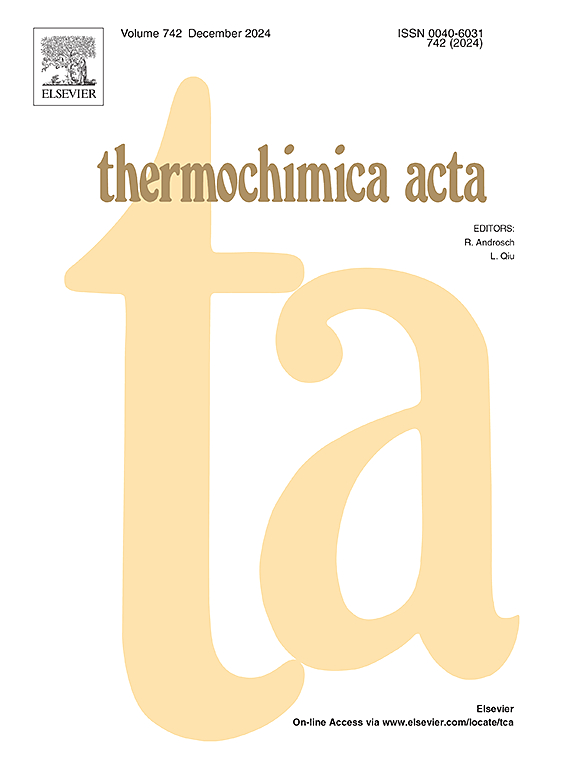Comparative study of the multistep thermal dehydration/decomposition of geopolymer pastes prepared using different active fillers
IF 3.1
2区 化学
Q2 CHEMISTRY, ANALYTICAL
引用次数: 0
Abstract
The present study focused on the multistep thermal dehydration/decomposition process of geopolymer paste samples prepared using distinct active fillers, including fly ash, blast furnace slag, and metakaolin. Besides the lower water content of the geopolymer materials compared with conventional Portland cement, the thermal dehydration/decomposition occurs as the multistep process. Water evolution behavior is critical for assessing its potential application as a construction material in water-resistant environment. The thermal dehydration/decomposition kinetics also plays a pivotal role in evaluating the thermal stability of geopolymer materials. This article presents the kinetic behavior of the multistep thermal dehydration/decomposition of different geopolymer materials in a stream of dry N2 or wet N2 with varying water vapor pressures. This investigation was carried out through a systematic experimental approach and detailed kinetic analysis. This study revealed that, irrespective of the samples, the two-step thermal dehydration/decomposition process occurred after the desorption of absorbed water. The kinetics of the initial reaction process, which is attributed to the thermal dehydration of bounded water, exhibited sensitivity to atmospheric water vapor. In contrast, the kinetics of the subsequent process of the thermal dehydroxylation of the binding phase demonstrated practically invariable behavior, irrespective of the atmospheric water vapor pressure. The latter was identified as a distinctive attribute of the irreversible process and as a pivotal process in determining the thermal stability of geopolymer materials.
不同活性填料制备的地聚合物膏体多步热脱水/分解的比较研究
研究了不同活性填料(粉煤灰、高炉矿渣和偏高岭土)制备的地聚合物膏体样品的多步热脱水/分解过程。此外,与传统硅酸盐水泥相比,地聚合物材料的含水量较低,热脱水/分解是一个多步骤的过程。水的演化行为是评估其在防水环境中作为建筑材料的潜在应用的关键。热脱水/分解动力学在评价地聚合物材料的热稳定性方面也起着关键作用。本文介绍了不同地聚合物材料在不同水蒸气压的干N2或湿N2流中多步热脱水/分解的动力学行为。本研究通过系统的实验方法和详细的动力学分析进行。本研究表明,无论哪种样品,在吸附水解吸后都发生了两步热脱水/分解过程。初始反应过程的动力学是由有界水的热脱水引起的,对大气水蒸气表现出敏感性。相反,结合相的后续热去羟基化过程的动力学表现出几乎不变的行为,与大气水蒸气压无关。后者被认为是不可逆过程的一个独特属性,是决定地聚合物材料热稳定性的关键过程。
本文章由计算机程序翻译,如有差异,请以英文原文为准。
求助全文
约1分钟内获得全文
求助全文
来源期刊

Thermochimica Acta
化学-分析化学
CiteScore
6.50
自引率
8.60%
发文量
210
审稿时长
40 days
期刊介绍:
Thermochimica Acta publishes original research contributions covering all aspects of thermoanalytical and calorimetric methods and their application to experimental chemistry, physics, biology and engineering. The journal aims to span the whole range from fundamental research to practical application.
The journal focuses on the research that advances physical and analytical science of thermal phenomena. Therefore, the manuscripts are expected to provide important insights into the thermal phenomena studied or to propose significant improvements of analytical or computational techniques employed in thermal studies. Manuscripts that report the results of routine thermal measurements are not suitable for publication in Thermochimica Acta.
The journal particularly welcomes papers from newly emerging areas as well as from the traditional strength areas:
- New and improved instrumentation and methods
- Thermal properties and behavior of materials
- Kinetics of thermally stimulated processes
 求助内容:
求助内容: 应助结果提醒方式:
应助结果提醒方式:


